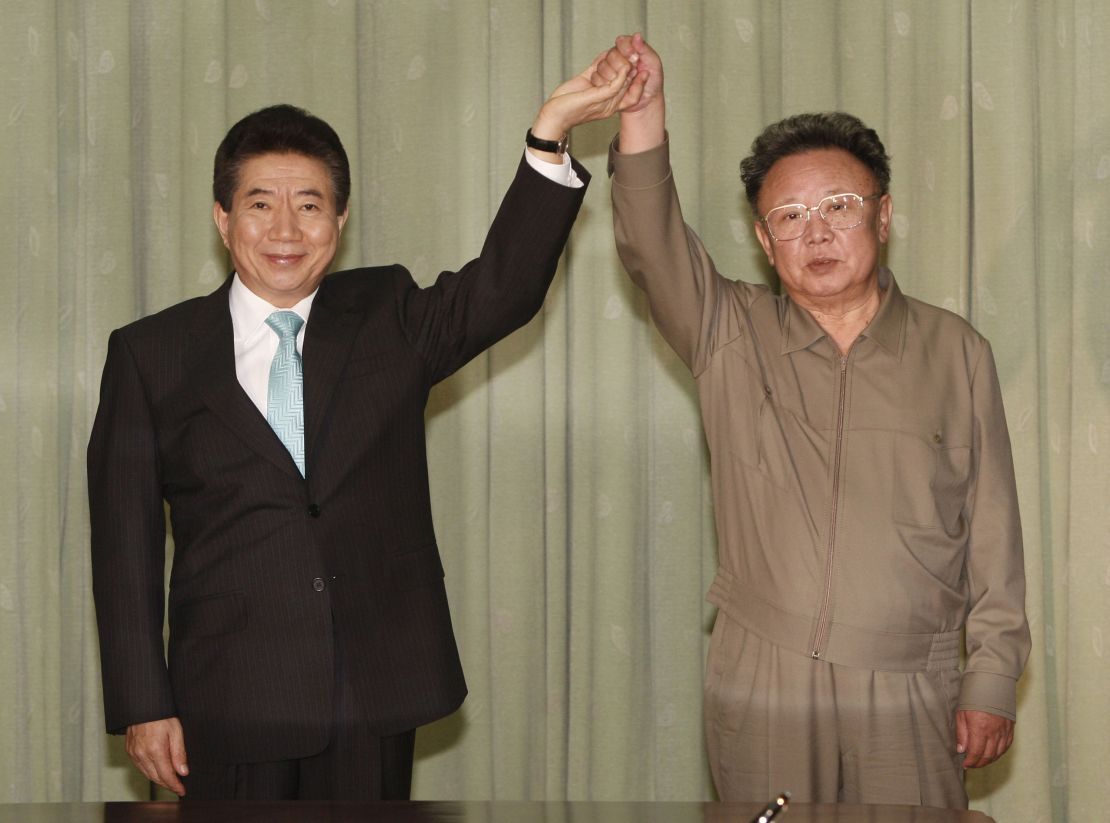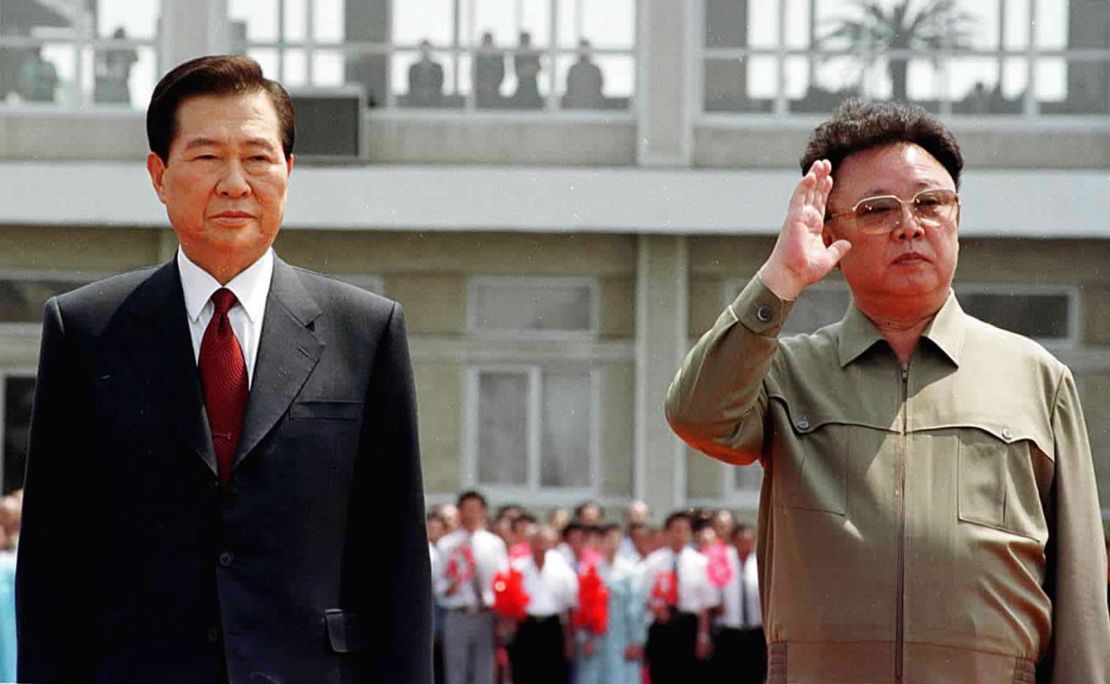When Moon Jae-in meets Kim Jong Un on Friday, he’ll be the third South Korean President to meet his North Korean counterpart.
Two of his predecessors, Kim Dae-jung and Roh Moo-hyun, each held talks with the late North Korean leader Kim Jong Il in 2000 and 2007, respectively.
While those summits achieved some tangible results, they failed to significantly move the needle when it came to ending the conflict on the Korean Peninsula.
But there are important lessons Moon can take away from the successes and failures of his predecessors.
When Kim Dae-jung and Roh arrived in Pyongyang, Kim Jong Il rolled out the red carpet for them – literally and figuratively.
The pomp and circumstance made for compelling images that were broadcast around the world, and that’s exactly what the North Koreans wanted.
By holding the previous two summits in Pyongyang, the South Koreans gave Kim Jong Il’s massive propaganda machine a home-field advantage.
The country’s state-controlled media presented the visits as the South Koreans traveling north to pay tribute. They could more easily control the flow of information and imagery coming from the meetings because they were hosts.
Both the Kim Dae-jung and Roh administrations knew the risks of greeting Kim Jong Il on his own turf and potentially coming back empty-handed.
In Kim Dae-jung’s case, “the North just had this attitude where they said ‘just come, everything will be fine.’ So, there were certain elements of uncertainty and anxiety,” Kim Dae-jung’s son, Kim Hong-gul, told CNN.
Though Roh eventually made the decision to to go to the North Korean capital, his administration was hesitant to do so, said Lee Jong-seok, Roh’s former National Security Council chairman and unification minster.
“We struggled over the location of the summit because the North was reluctant to come to Seoul and we were reluctant to go up to Pyongyang for the second time,” Lee told CNN.
The optics were bad for both South Korean leaders. In each case, Kim Jong Il gained the propaganda victory of his sworn enemy coming north to meet him, without agreeing to anything that ultimately reduced tensions in the long term.
Moon will meet Kim at the Peace House on the southern side of the Joint Security Area (JSA), the only part of the demilitarized zone (DMZ) that divides the two Koreas where soldiers from each side stand face-to-face. Peace House is on the southern side of the DMZ.
The choice was largely viewed as a compromise between the two leaders. While the spartan locale will lack the grandeur of the previous two summits, Moon appears to have secured an important propaganda victory of his own.
South Korean journalists will be allowed to cross into the northern side of the DMZ to capture the moment when Kim Jong Un crosses south.
When Kim Dae-jung traveled to Pyongyang in 2000, the United States and South Korea were working closely to align their diplomatic outreach to North Korea.
Kim Dae-jung left Pyongyang with a handful of deals, specifically to reunite families separated by the Korean War and to provide investment for the dire North Korean economy.
Then-US President Bill Clinton followed up that summit by sending his secretary of state, Madeleine Albright, to Pyongyang to meet with Kim Jong Il and to host one of North Korea’s most powerful officials in Washington. Kim Jong Il accepted an invitation to visit Seoul at a later time, but he never made the trip.
By contrast, Roh had developed a reputation as anti-American. Former US Secretary of Defense Robert Gates confirmed those rumors in his memoir years later, saying Roh told him “the biggest security threats in Asia were the United States and Japan.”
When Roh traveled North in 2007, he was an unpopular lame duck president with only months left in his term, and wanted to lock in a deal that would ensure the South would continue to provide North Korea with aid after he left office.

“Roh Moo-hyun hoped that the next administration, which he knew was certain to be conservative and center-right, would keep some of the vestiges of his policies,” said Andrei Lankov, a professor at Kookmin University and expert on North Korea.
“He wanted to make as many agreements as possible just to basically push it on his successor.”
Like Kim Dae-jung, Roh left Pyongyang with some deals. An eight-point peace plan was headlined by an agreement that both sides should push for a permanent treaty to end the Korean War.
But unlike Kim Dae-jung, Roh returned home without strong domestic and international support for his efforts.
His successor Lee Myung-bak chose not to uphold parts of the deal to continue economic assistance to Pyongyang with relatively few strings attached. Instead, he stipulated any aid or money given to North Korea was contingent on Kim Jong Il agreeing to abandon its nuclear weapons program.
US President George W. Bush was said to have embraced Lee Myung-bak and his more tougher approach to inter-Korean relations.
“Past experience shows that South Korea hit the wall in its policy on North Korea when it failed to persuade America, its major ally, to support Seoul’s North Korea policy,” said Lee Seong-hyon, a researcher at the Sejong Institute in Seoul.
Moon’s been in office for less than a year, during which time he’s embraced his role as man in the middle balancing Pyongyang and Washington.
To keep the Trump administration abreast of Seoul’s moves, Moon has consistently dispatched key aides to the US capital for talks. The South Korean foreign minister, national security adviser and top spy all traveled to Washington last month for talks with their counterparts or high-ranking US officials.
In March, Trump agreed to hold a separate summit with Kim Jong Un after the invitation was delivered to him in person by two South Korean officials who had met Kim in Pyongyang.
“Moon knows that South Korea’s approach on North Korea will be much more effective when it has American understanding on its side,” Lee Seong-hyon said.
Kim Dae-jung was the architect of what was known as the Sunshine Policy, pursuing closer economic and diplomatic cooperation with Pyongyang in the hope of easing tensions and staving off an economic collapse in the North. Moon is considered one of the key architects of the policy and served as a top aide to President Roh.
At its heart, the Sunshine Policy was inextricably linked with money. The North Koreans wanted the aide to keep their country afloat, and ultimately – and secretly at the time – the South Koreans gave it to them with little or no strings attached.
Kim Dae-jung’s legacy seemed secure after he returned from his summit in Pyongyang, especially after he was awarded the Nobel Peace Prize for his efforts. But his image took a serious hit three years later, when news broke that South Korea secretly funneled nearly $200 million dollars to the the North Koreans through the Hyundai corporation just days before the talks.

Kim publicly apologized for the surreptitious payment, but insisted the money was for business deals in North Korea. Kim Dae-jung had hoped Kim Jong Il would use the money for Chinese-style reforms to kickstart and partially liberalize the North Korean economy.
But that didn’t happen, and many South Koreans came to the conclusion that the millions of dollars of aid given to Pyongyang failed to halt their weapons programs and did not properly serving Seoul’s interests.
Today, an under-the-table payment to the North Korean regime would be an extremely risky move for Moon, considering he was elected after fashioning himself as a “clean candidate” while campaigning for the presidency.
South Korea was looking for an honest leader to replace the conservative ex-President Park Geun-hye, who was ousted in a corruption scandal. She’s since been sentenced to 24 years in prison.
“Any money transfer is toxic in South Korea in domestic politics and Moon’s mandate is based on transparency,” said John Delury, a professor at Yonsei University’s Graduate School of International Relations. “They’re going to be highly sensitive and resistant.”
And any payment by Moon’s administration would likely violate the crippling international sanctions levied on North Korea by the United Nations Security Council, an effort spearheaded by the United States. Trump has declared his administration’s “maximum pressure campaign” will continue as talks with Pyongyang get underway.
“In the current state of affairs, pretty much any meaningful economic cooperation with North Korea goes against existing UN Security Council resolutions. There’s very few exceptions,” said Lankov.
“Moon Jae-in cannot afford to challenge Donald Trump and to do something that might drive Mr. Trump crazy.”


